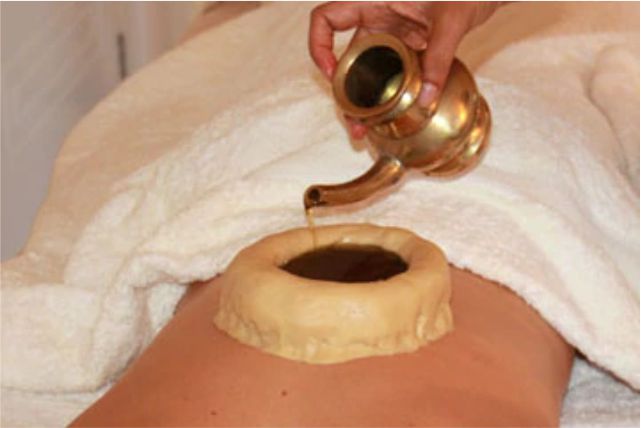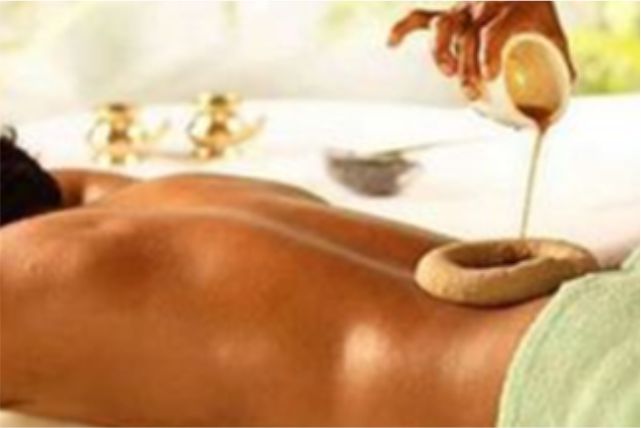
Kati Basti is an Ayurvedic healing treatment in which medicated oils are poured and pooled for a fixed duration of time in a compartment or a cabin constructed over the low back area using a ring of dough made from the wet flour of black gram (urad dhal) that covers the Lumbo-sacral and Sacro-iliac joints.
Lower back pain is a disorder involving the muscles and bones of the back. It affects about 40% of people at some point in their lives and is a common disease that has haunted human beings for centuries. Nurses, teachers, sportspeople, people who do physical, manual and heavy work, and even those who work in offices, would have experienced a sore lower back of various intensities at some point in their lives.
The food we consume today, together with our lifestyle and activities, our lowered immunity, frequency and mode of travel, metabolic diseases including obesity and so on, the stress, rush and push in life have all contributed to and indicted in increasing the graphical picture and global incidence of lower back pain. It is among the top listed diseases for which patients visit clinics to seek medical attention.
Ayurveda has the status of offering the best remedies for lower back pain and related painful conditions. Among the various remedies available for low back pain, Kati Basti is the most popular. People who have experienced Kati Basti treatments would definitely tell you how they felt at the end of the course of their treatment. It is not surprising when those undergoing Kati Basti report that they had almost forgotten that they had pain in their back, such is the patient’s benefit from this treatment.
What is Kati Basti?
The term has 2 words:
Kati means low back
Basti (Vasti) means to hold and refers to a compartment, vessel or container which holds.
Kati Basti is a treatment in which medicated oils are poured and pooled for a fixed duration of time in a compartment or a cabin constructed over the low back area using a ring of dough made from the wet flour of black gram (urad dhal) that covers the Lumbo-sacral and Sacro-iliac joints.
In simple words, Kati Basti is Ayurveda’s pain-relieving, oil-pooling treatment conducted for lower back pain.
Basti or Vasti is a term used to describe the urinary bladder in Ayurveda. The urinary bladder is a bag that holds urine for a certain amount of time until it is voided. Similarly in Kati Basti a compartment is constructed over the low back area by using flour of black gram and the pain-relieving medicated (herbal) oils are pooled in this compartment for a fixed duration of time. Hence the procedure is called Kati Basti.
In which conditions is Kati Basti beneficial?
Kati Basti is highly beneficial in the following conditions:
Lower back pain (lumbago)
This is a common disorder of the lower back involving the muscles and bones of the back.
Lumbar spondylosis
This is a type of degenerative osteoarthritis of the joints of the bones forming the lower back.
Sciatica
Sciatica is pain affecting the back, hip, thigh and outer side of the leg, caused by compression of a spinal nerve root in the lower back, often owing to degeneration of an intervertebral disc. Thus Sciatica is nerve pain from irritation of the Sciatic nerve. The pain along with tingling, numbness, and weakness start in the lower back and travel downwards through the back of your thigh and outer side of the leg on the affected side.
Sacroiliac joint pain or dysfunction
This is a disease of the sacroiliac joint which causes lower back and/or leg pain. The pain is typically felt when the dimples or pits (hollow) on either side of your lower back are pressed or compressed manually. The pain experienced can spread down the leg and a little upward too.
Coccydynia
This is a medical term given to a pain in the coccyx or tail bone pain, usually brought on by sitting too abruptly.
Intervertebral disc prolapse (IVDP) or Lumbar disk disorders or Spinal disc herniation
This is a frequent source of low back pain. In between every 2 vertebrae (bones making up your backbone) there is an intervertebral disc, a soft cartilaginous cushion that allows free movement of the spine (your backbone). When these discs bulge, protrude, extrude or are sequestered, they press on a nerve root thus leading to pain and other symptoms in the leg.
Spondylolisthesis
This is a condition in which there is a forward displacement of a vertebra, especially the 5thLumbar Vertebra, where there is general stiffening of the back, lower back pain and tightening of hamstring muscles (muscles making the back of your thigh), a leaning-forward pose (kyphotic), a waddle while walking (duck type walking) and a shooting pain along the course of sciatic nerve (involving pain in the back of thigh and leg).
Spina bifida (occulta)
This is a birth defect where there is an incomplete closing of the backbone and membranes around the spinal cord. It presents with leg weakness and paralysis, club foot, hip dislocation, bladder and bowel control problems and so on.
Benefits of Kati Basti
Relieves pain in the low back and lower limbs
Relieves stiffness in the low back and lower limb
Relieves swelling and inflammation in the low back, in the bones and soft tissues of the low back
Brings lightness and a sense of health in the lower portion of the body
Improves movements at the back and lower limbs and enable us to move and work freely
Strengthens the low back (bones, muscles and soft tissues therein)
Soothes the nerves supplying the low back and legs (lower limbs)
Enhances blood supply to the low back area
Read related
Healthy Back by Shanti Gowans
How is Kati Basti done?
Kati basti is done in the following method:
PURVAKARMA, Pre-treatment procedures
This includes:
Preparation of the patient:
The patient is thoroughly examined.
Their Prakriti (basic constitution) and Vikriti (details of morbidity) are documented in detail.
The disease is also examined.
The treatment line-up, materials, and medicines that need to be used are enlisted.
The patient is given a sadhyo-virechana (instant purgation) for detoxification. This will also evacuate the bowel and reduce the pressure over the back and thus enhance the effect of the Kati Basti treatment.
Preparation for the treatment:
Materials needed for the treatment are collected beforehand. They are:
For Kati Basti (oil pooling)
Taila (medicated oil), Ghee (medicated ghee) or both, suitable to the disease and patient are collected and stored beforehand. The same medicines are used for conducting Abhyanga (massage) after the completion of Kati Basti procedure
Flour of black gram (urid dhal)
Water
Stove, bowls, vessels, spoons, etc
Sterile cloth
For Churna Pinda Sweda
Herbal powders such as Rasnadi Churna, Kottamchukkadi Churna, Jatamayadi Churna, Ellumnishadi Churna, Grihadhoomadi Churna, Kolakulattadi Churna, etc are collected for Churna Pinda Sweda (Powder bolus fomentation).
Churna pinda sweda
Kati Basti or oil pooling is a sthanika sneha (local oleation) procedure. It provides extra-ordinary relief if done on a dry surface of the back. Dryness is created by conducting a rukshana procedure, namely Churna pinda sweda.
Churna pinda sweda is administered for a couple of days before starting Kati basti as a part of pre-treatment procedures. The aim is to cause rukshana (drying therapy) before conducting Kati basti.
Method for Churna pinda sweda
The appropriate herbal powders are chosen according to the nature of the disease, symptoms and dosha involvement.
– Rasnadi churna is used when pain predominates,
– Jatamayadi churna is used when inflammation predominates etc.
The powder is heated on a pan and tied in a sterile cloth so as to form a bolus.
A couple of such boluses are kept ready.
After giving a massage to the lower back with herbal oils, hot fomentation is given with the powder boluses. This brings about Rukshana (dryness).
– The powder should be used in a dry form if symptoms of ama (metabolic wastes created by low metabolism and indigestion which have a sticky nature and has a tendency to produce pain and stiffness) and morbid kapha-like pain, stiffness, swelling, etc are found in the low back.
– If the pain is of a dry nature, with the involvement of morbid Vayu, the powder may be heated by frying it in oil and used for pinda sweda.
Churna pinda sweda is done for 30-45 minutes daily for 2-3 days prior to Kati Basti.
